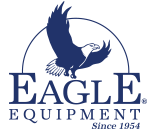At Eagle Equipment we do everything we can to ensure the safe and timely delivery of your automotive repair equipment, but we recommend you inspect your merchandise thoroughly before signing the Bill of Lading.
Eagle Equipment creates a Bill of Lading (BOL). When the freight company arrives at our loading dock, the driver is responsible for inspecting all items before they are loaded. Inspection includes documenting the number of items, the weight of each item, the condition of the items, and the packaging (crating). The driver has the right to refuse shipment if it does not meet specifications. Once the driver signs the Bill of Lading the equipment becomes property of the freight company. The equipment remains property of the freight company until the customer signs the Bill of Lading. Upon delivery the customer is responsible for inspecting the equipment carefully for any type of damage. Customers should ask the driver to inspect the shipment with them. A description of any damage should be written on both the customer’s copy and the freight carrier’s copy of the Bill of Lading prior to signing for the receipt of equipment. If the customer finds the damage is excessive they may refuse the shipment by not signing the Bill of Lading. Avoid hidden or concealed damage by opening all packages in the presence of the delivery driver and inspect the contents carefully. If this is not possible at the time of delivery do not move the packages until they have been inspected. The National Motor Freight Traffic Association guidelines allow 15 days for hidden damage freight claims to be filed. The customer is responsible for noting damage on the Bill of Lading, notifying the carrier, and filing freight damage claims.
Guidelines for filing a freight claim:
•Regular freight claims should be filed within the required nine-month time period.
•Hidden damage freight claims and shortage claims should be filed within 15 days of delivery.
•Collect the required documents to support your claim:
- Standard claim form from the carrier with the claim amount
- Invoice copy with the amount paid
- Bill of Lading copy
- Packing slip copy
Eagle Equipment will assist our customers with the freight claim process by furnishing the correct contact information. In the end your claim and all supporting documentation should be sent to the freight carrier for payment.
